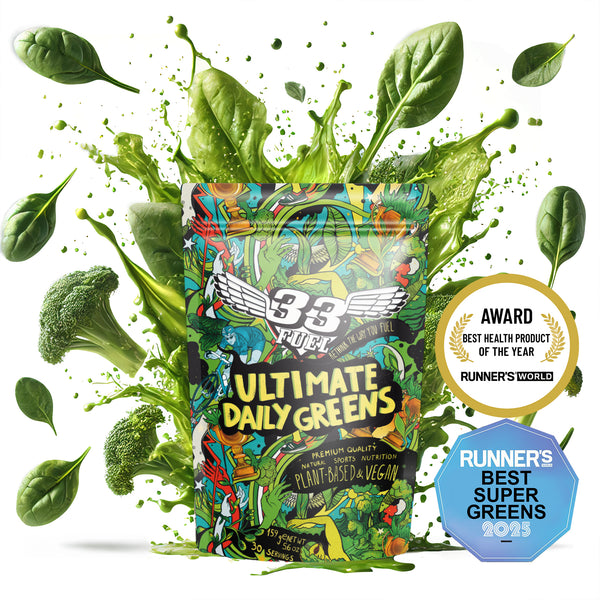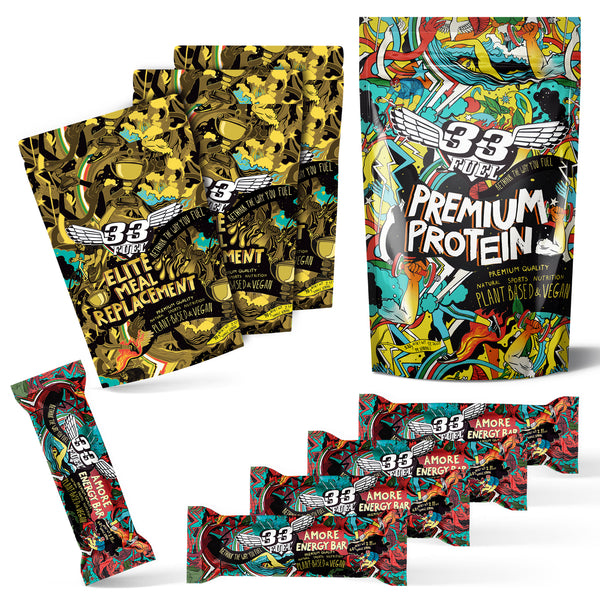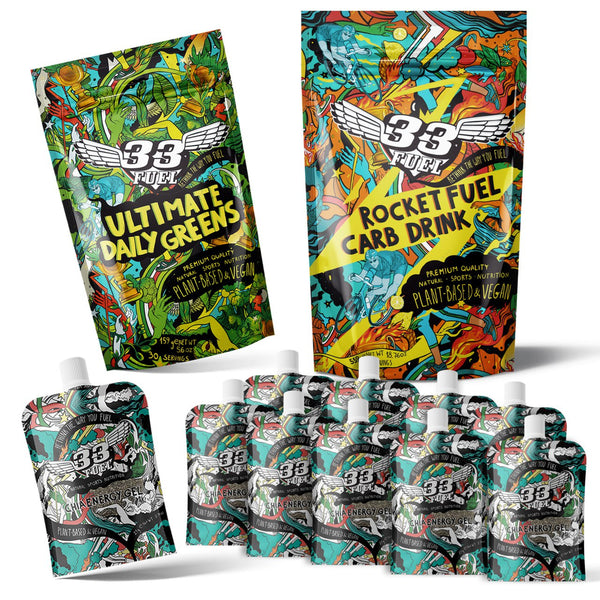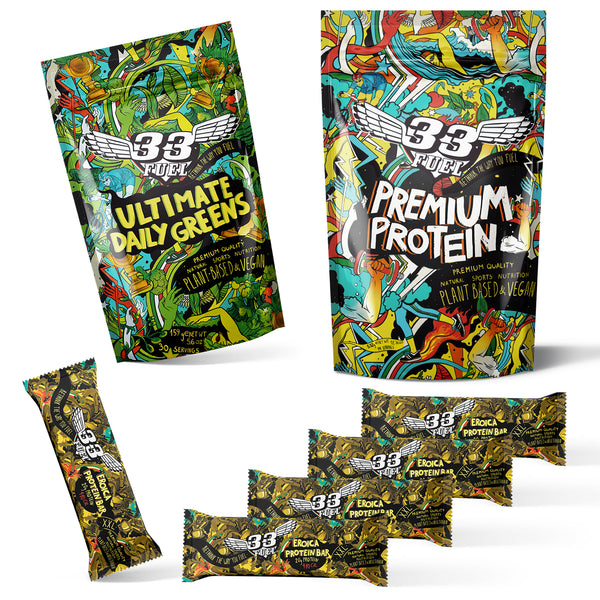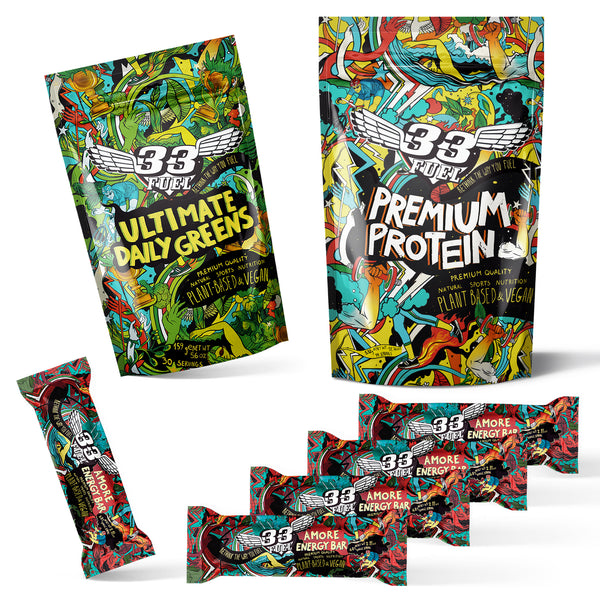Best marathon fueling strategy

What's the best marathon fueling strategy to battle a sensitive stomach?
Great question this one, and one we hear a lot at 33Fuel so here’s a simple overview of what the best marathon fueling strategy looks like and how you can avoid stomach issues on your long runs or other longer training sessions.
There are three key elements to master:
- Daily diet
- Your fat burning base
- Race day fueling strategy
Best marathon fueling strategy #1: your daily diet
- As four time World Ironman Champion and 33Fuel athlete Chrissie Wellington explains: “sports nutrition is not just what I eat on race day - my daily diet is my sports nutrition too”.
What you eat and how you eat on a daily basis plays a huge part in your performance. Race day success begins a long time before race day.
But fear not, this doesn’t mean eating like a monk, depriving yourself of all food enjoyment and hating every minute. It simply means a powerful, nutrient dense diet, with a focus on whole foods:
Go big on:
- Fruit and veggies - it’s impossible to eat too many of these
- Beans, legumes
- Nuts, seeds
- Water

Fruit and veg are the business for performance. Go big on these babies or go home
Reduce:
- Animal products - meat, fish and dairy. If you do eat these, go organic whenever possible
- Rice and pasta - fill rice/pasta-based dishes with veg and beans to dilute rice/pasta portions
- Alcohol
- Caffeine - coffee is the main player here, but remember both black and green teas also contain caffeine. This post deals with caffeine for athletes and performance in detail
Remove:
- Processed foods - obvious contenders like ice cream, burgers, and ready meals are easy to spot. Beware the sleepers like salad dressing and other sauces. Most are chock full of crap. When eating out and ordering anything with a sauce/dressing that may be suspect, just ask for it on the side. That way your meal’s not trashed if it turns out to be one you'd rather avoid
- Sweets/candy
- Bread
With your diet squared away now it’s time for some self analysis. You need to know this stuff is working after all. No need for blood testing, gadgets or men in white coats. Instead just keep an eye on:
- Digestion: is everything still flowing smoothly, is your stomach generally happy and relaxed, and are you free of bloating?
- Sleep: are you sleeping and waking well, and feeling rested after a night’s kip?
- Tongue, eyes and skin: these are some of the best health indicators around - tongue should be pink and free of lumps, bumps and patches; the whites of your eyes should be just that, white and not yellow, and your skin should be spot and flake free
- Nails and hair: nails stay strong, hair stays shiny
When any of the above deviate significantly from the norm, it’s a good sign something dietary may not be working.
Remember, many other lifestyle factors can also affect you here so if you’re working 18 hours a day on a big stress project, are moving house and have three children under the age of five then this is going to play a way bigger role in your overall wellbeing than whether or not you had a croissant for breakfast!

Bob is delivering an important presentation. He has not slept in three weeks to get this sucker ready. Despite a great diet and being teetotal, he currently feels like he has been binge drinking since Christmas 2011. This has nothing to do with his diet and everything to do with Bob being stressed out of his nut
Another handy note - if aligning your diet with the guidlines above involves major changes then you’ll need a month anyway for your body to adjust as your gut bacteria adapt. Minor bloating, lethargy and particularly cravings are very normal in this period.
Best marathon fueling strategy #2: build your fat-burning base
By increasing your ability to naturally fuel from stored fat you will not only make yourself faster and more efficient, you’ll also need to use less nutrition products during your training and racing.
This is because stored body fat is a readily accessible fuel source, and even a lean body is carrying enough to fuel you for days.The higher you can raise the threshold below which you primarily burn fat, the fewer nutrition products you’ll need to take on board while exercising which means less stress on your stomach and a much better chance of happy running.
This is stuff no other nutrition company will tell you - the truth is, you don’t need anywhere near as much product as less scrupulous brands will have you believe.
Build your fat-burning base by:
- Incorporating fasted training runs into your routine - pre-breakfast is ideal
- Keeping at least one run a week significantly steady - by maintaining your conversational pace (ie: you can still hold a conversation) throughout a session it will feel like you’re not doing much work, but in fact you’re doing priceless work to increase your fat-burning abilities
- Reducing carbs in your diet, while increasing good fats (nuts, seeds, avocados and oily fish)
Best marathon fueling strategy #3: race day nutrition strategy
With diet and fat-burning taken care of you’ve now built the best possible base for race day performance and put yourself square in the sweet spot for a stomach-issue free race. Boom!
Now you need to make sure you guarantee that by executing the perfect marathon fueling strategy when it counts most.
The key elements here are: fuel sources, and timing.

Great diet + efficient fat-burning + whole food race day nutrition = PB. Note: hiding in the pack on a bicycle and hoping no-one will notice like the guy on the left here is generally frowned upon
Fuel sources
Real food sources are the best possible fuel for your performance, and come with the smallest chance of ever causing an issue. It’s food after all, our bodies have been eating it for thousands of years and loving it.
We’re talking bananas, dates, nuts, homemade rice cakes, and anything that can genuinely be recognised as being made of unprocessed whole food ingredients.
Best Sellers
This is why our Chia Energy Gels are uniquely formulated to be made using powerful, natural whole foods only and are the only energy gel in the world that does. Designed specifically for endurance sports these are made to deliver strong and stable energy, great taste, and a happy stomach for as long as you want to go, whether that’s 10K or 200 miles.
To every athlete who says they hate energy gels, we simply say: you haven’t tried ours.
On the flip side, synthetic lab-based goo gels that look like hair gel and taste worse are to be avoided. They are as far from real food as anything can get. The same goes for the drink powders and fizzy electrolyte tabs.
And for hydration, water is all you need.
So many athletes we see make the mistake of going to all the work of cleaning up their diet, building their fat-burning base and basing race day on whole food nutrition, only to go and balls the whole lot up by pouring down two litres of liquid sugar and sweetener.
Timing
Through your training you’ll know roughly how often you need to eat something while training or racing, what you need to do now is evolve that strategy.
In training, when you hit that point, say 45 minutes in, when you think you should be eating, take a beat and ask yourself instead: ‘am I hungry?’
If the answers ‘yes’, then you eat. And if it’s a ‘no’, then you hold off.
Make a note to check in with yourself again in, say, 15 minutes and repeat the process until you hit a ‘yes’. Then eat, and reset mentally to repeat the process at the next 45 minute mark, unless hunger strikes earlier. This blog post explains the process in more detail.
It sounds very simple, but it’s very hard to do.
There’s the fear that if you don’t eat in time, you’ll bonk and your race will crumble, and with this fear stoked by so many sports nutrition companies (because they know it sells you a boatload of product you don’t need) resistance is tough.

'If you don't eat loads when you're running you'll bonk and the bogeyman will get you', or somesuch other nonsense is exactly as ridiculous as it sounds. This is sports nutrition companies simply trying to get you to buy product you don't need
You need to be strong. Because following that fear leads to over-fueling, which in turn leads to you puking all over your fancy new race kicks at mile 18, which genuinely is scary, particularly for any spectators who have to watch.
Instead trust that your fat-burning base has your back, and if you practice in training using the technique above, you can become so attuned to your hunger signals you will literally be incapable of bonking.
Put this little lot together and you will have attained marathon fueling nirvana. Nice work!
More performance-boosting content
From the 33Fuel Podcast
From the 33Fuel Vlog
Related content
Dairy and athletic performance - good or bad?
Booze and your performance - the health effects of alcohol
Coffee and athletes - harness caffeine to your advantage with this simple guide
Why you need less sports nutrition than you think
How often should I take a gel? Perfect your nutrition timing here
33Fuel™, fueling limitless performance since 2012
